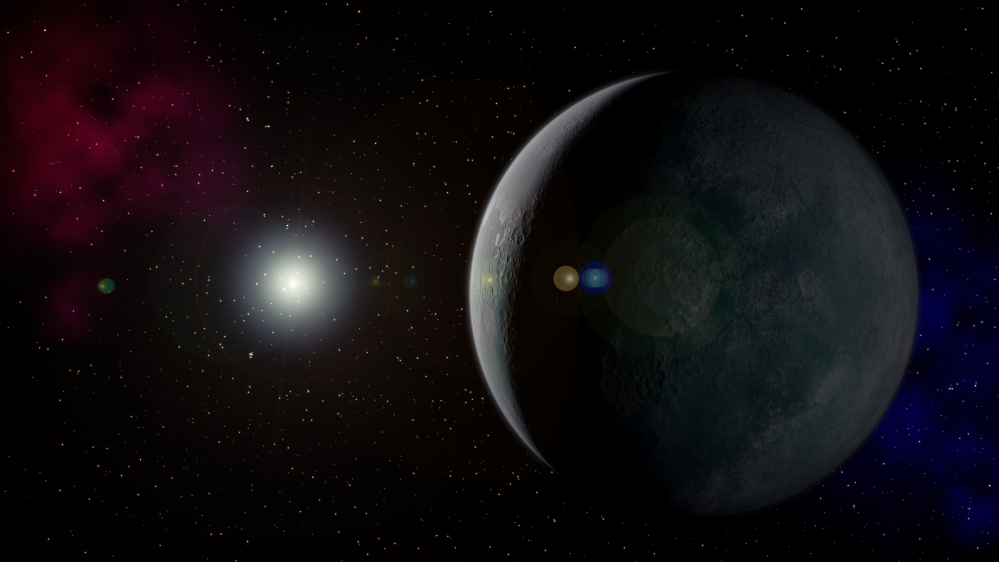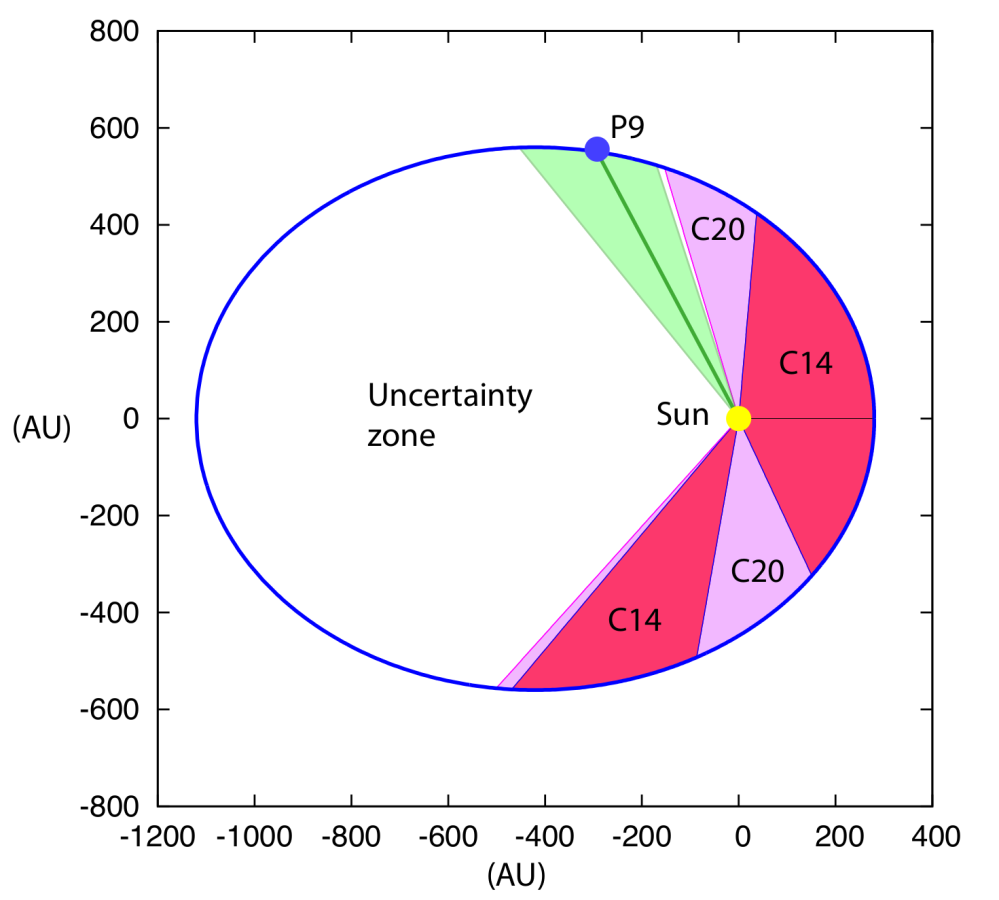A little over a month ago, Caltech astronomers Konstantin Batygin and Mike Brown announced new calculations that suggest there IS a ninth planet in the outer solar system. The planet has to be very distant and can’t be very big or hot, otherwise we would have seen it already. Of course, to prove it’s more than just a mathematical curiosity, you need to find it. Now other astronomers are starting to weigh in.

Batygin and Brown’s arguments for the existence of Planet Nine are mostly based on three things:
- The Kuiper Belt – think of it as a second asteroid belt beyond Neptune, but full of icy objects – increasingly seems to have an inner and outer edge. The inner boundary is clearly caused by Neptune; the outer boundary should be due to some other object.
- There are Kuiper Belt Objects with orbits that take them very far from the Sun*, and they’re all on inclined orbits (tilted relative to the plane of the solar system). This is something that we think can only be accomplished by encounters with a large object… except these Kuiper Belt Objects are always too far from the Sun to be affected by Neptune.
- All of those distant Kuiper Belt Objects have orbits oriented in a very similar way, with their perihelions (closest approach to the Sun) all lying in the same part of space. The chance of that happening at random is enormous, and again suggests a large object is controlling their orbits.
The calculations Brown and Batygin did suggested a 10-Earth-mass planet (somewhat smaller than Neptune at 17 Earth masses) in an orbit with a semimajor axis of 700 AU, which would make it something like 20 times more distant than Neptune. That’s pretty much the only way you could hide a planet in the extreme reaches of the Solar System such that we wouldn’t have seen it. Of course, the proof is in the finding, and they don’t know exactly where this planet should be… and that’s a lot of space to look through.
Just as with Tabby’s Star, there are now a large number of papers following up on Planet Nine. Many of them are attempting to double-check Batygin and Brown’s assumptions about the existence of Planet Nine: Gongjie & Adams (2016) find it unlikely that Planet Nine exists because it should have been thrown out of the Solar System by now. Paučo & Klačka (2016) find the orbits of the outer Kuiper Belt objects could be explained by a different theory of gravitation called QUMOND rather than a planet.
Some are attempting to help characterize it. Linder & Mordasini (2016) compute the likely properties of Planet Nine using exoplanet theories. Iorio (2015) thinks that the most useful test of its existence will be data from the New Horizons space probe, currently on its way toward the Kuiper Belt object 2014 MU69. (That paper looks like it came out before Batygin & Brown’s paper because the original version of the paper was actually commenting on the planets ALMA thought they’d found)
More interesting is Fienga et al. (2016), (also reported here and here) which manages to rule out large portions of Planet Nine’s orbit using a different technique than Batygin and Brown did: ephemerides. Ephemerides (pronounced ef-em-er-ih-dees, and nothing like ‘ephemeral’, as I once embarrassed myself with) are tables of positions of the planets (or simple equations for position) over time, including the Newtonian and Relativistic effects from all the other objects in the Solar System. Modern ephemerises are highly complex supercomputer operations, that yield tables of planetary positions accurate to within a kilometer. JPL uses theirs to guide spacecraft.
Agnes Fienga maintains the INPOP Ephemerides, so they have all the computations, data, and expertise necessary for highly accurate simulations of the Solar System. They popped Planet Nine into their physics simulations at a number of positions along its orbit, and looked at what it did to Saturn. We’ve known the orbit of Saturn extremely well for the last nine years, thanks to the Cassini spacecraft.

The end result was that Fienga and coauthors managed to rule out large chunks of sky: If Planet Nine was in any of those places along its orbit, it would have produced noticeable changes in the orbit of Saturn and we would have already suspected the existence of Planet Nine. That means there’s a smaller area to cover with telescopes.
They propose that it would be incredibly useful to have Cassini’s Saturn mission extended to 2020 to increase the time coverage of Saturn’s orbit. I doubt this will happen, though: Cassini’s fuel (and operating budget) runs out in 2017, at which point it will be directed to use the last of its reserves to crash into Saturn**. I’m not sure they’d be able to stretch one year of maneuvering fuel out four years, but even if they did that would probably involve ending the Cassini mission immediately and skipping the last year-and-so of scientific studies. Hopefully, Iorio’s idea of using New Horizons for that task will pan out instead.
Lastly, there’s a paper by Cowan et al. (2016) that proposes using cosmology surveys to find Planet Nine. They’ve done some checking, and have determined that millimeter-wave cosmology studies meant to look at the Cosmic Microwave Background at the edge of the visible Universe might be perfect for finding Planet Nine. Those studies see (and have to carefully remove) lots of foreground asteroids and Kuiper Belt objects; one of those might actually be observations of Planet Nine.
So, as yet there’s no proof of the existence of Planet Nine, but astronomers are starting to put together theories and observational tests to find it. The hunt is on!
*In fact, these distant iceballs spend most of their time well beyond the Kuiper Belt, so calling them Kuiper Belt Objects is a bit of a misnomer. I’ve heard the term “Scattered Disk Object” before, but not recently, so I suspect it’s fallen out of favor.
**They’re crashing Cassini into Saturn to preserve the moons like Titan and Enceladus. If we just left Cassini in unpowered orbit of Saturn, it would eventually (over decades or centuries) crash into one of Saturn’s moons, and we don’t want stray microbes on its surface invading and destroying (theoretical) native Titanian life. The same thing was done with the Galileo space probe in 2003, to protect Europa. In contrast, NASA heavily sterilizes the Mars rovers.
Other posts about the edge of the Solar System: Pluto was Never a Planet, on the Exploration of Pluto, in which Pluto is Revealed, on the Most Distant Object in the Solar System, on the Saga of Planet Nine, on the Secrets of Pluto
I guess proof will only come if Planet 9 is discovered. Or not, after the sky searches are completed. The fact that the hypothesis is being tested against counter theories and alternate planetary movements says the scientific method is still robust.
LikeLike
I’ll admit this post mostly sidestepped the still-open question of whether Planet Nine even exists, or which of the many versions (and slight variations) exists. Those will definitely be tested in the upcoming months/years.
LikeLiked by 1 person